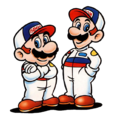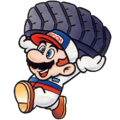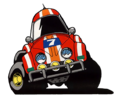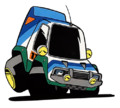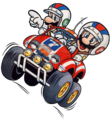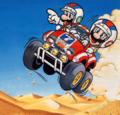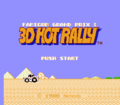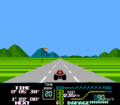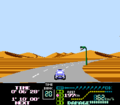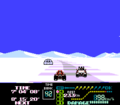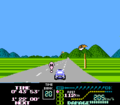Famicom Grand Prix II: 3D Hot Rally
| Famicom Grand Prix II: 3D Hot Rally | |
|---|---|
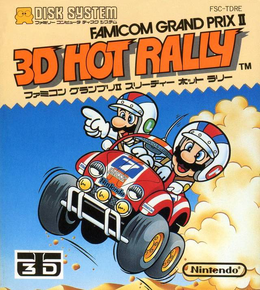 For alternate box art, see the game's gallery. | |
| Developer | Nintendo EAD HAL Laboratory |
| Publisher | Nintendo |
| Platform(s) | Family Computer Disk System |
| Release date | |
| Genre | Racing |
| Mode(s) | Single player |
| Media | FDS:
Floppy disk
|
| Input | NES:
|
Famicom Grand Prix II: 3D Hot Rally (ファミコングランプリII スリーディーホットラリー) is a racing video game released in Japan for the Family Computer Disk System. It is the sequel to Famicom Grand Prix: F1 Race, although the two games are very different. Like its predecessor, it too was subject of a tournament which was held from April 14 to May 31, 1988. The top 100 players of each class of car received a trophy in the form of a gold car of their class encased in quartz crystal with their name and rank on the base. Thus, there are 300 such trophies. They and thousands of runners-up and raffle winners received a "Pretty Mini", which is a yellow stationery set in the form of Diskun, the FDS mascot. It is similar to a white stationery set that was sold in stores.[1][2] They also received mock driver's licenses.[3] The game supports the Famicom 3D System, allowing the player to see the screen in three-dimensions by wearing a specialized set of goggles. The game's name makes note of said capabilities.
Famicom Grand Prix II: 3D Hot Rally marks the first time that Luigi appears taller and thinner than Mario on a game's box art, though this design was established in official artwork for Super Mario Bros.: The Lost Levels and in the film Super Mario Bros.: Peach-hime Kyūshutsu Dai Sakusen!.
This game, along with its predecessor, is a possible ancestor to the Mario Kart series, most likely due to the fact that it features Mario and possesses similar 2D racing mechanics, which was later carried on to Super Mario Kart.
Gameplay
Famicom Grand Prix II: 3D Hot Rally is a racing game with similar gameplay to that of Rad Racer. There are three different courses in the game, and they all have several multiple paths that split up that players can choose between. Before the race begins, the player can choose a repair point. This acts as a check point that repairs damage sustained by the vehicle, such as when it crashes into obstacles. A damage indicator on the bottom right of the game will display the vehicle's condition; once the damage indicator is fully depleted, the game will end. The player can opt to pause the game and select "Repair" from the menu to avoid this, but depending on how much damage the vehicle has sustained, the longer this repair will take.
The game is not a traditional racing game in the sense the goal is not to finish first, but rather to finish before the timer ends. The player starts with 20 seconds in the "Time Bank". Each alternate path, or "leg", of the course has a predetermined expected time frame of completion. If players do not meet that time frame, the seconds from the Time Bank will subtract. However, if players finish the leg in under the expected time indicated, the seconds remaining from it will be added on to the Time Bank. If the Time Bank is fully depleted, the game will end.
Scattered throughout the course in groups of five are Hot Dots: collecting eight of them will grant the vehicle an additional gear for a temporary 15 seconds that allows it to speed up to 300 km/h.
Characters
Main Characters
Vehicles
| Vehicle | Top Speed | 1/4 Mile | Highway | Grass | Snow | Sand | Dirt |
|---|---|---|---|---|---|---|---|
Kattobi |
220km/h | 13.71 sec. | ★★★ | ★★★ | ★☆☆ | ★☆☆ | ★☆☆ |
Yonque |
200km/h | 17.03 sec. | ★★☆ | ★★☆ | ★★★ | ★★☆ | ★★☆ |
Monster |
180km/h | 15.59 sec. | ★☆☆ | ★☆☆ | ★★☆ | ★★★ | ★★★ |
Obstacles
Abunaiwa
(Boulders)Nanisuruki
(Shrubs)Jamadatō
(Street lamps)
Collectible
Staff
- Main article: List of Famicom Grand Prix II: 3D Hot Rally staff
Development
Famicom Grand Prix II: 3D Hot Rally was shown to Nintendo of America, who heavily criticized the game, particularly the "cute" design of the vehicles, and stated it would not sell. This reaction made director Kazunobu Shimizu furious and was one of the drivers behind the graphical style of F-Zero.[4]
This game is one of eight that is compatible with the Famicom 3D System. The flyer for the tournament advertised this system.[5]
Gallery
Artwork
Mario holding a tire
A tired Mario and Luigi, resting
- 3DHR obstacles.png
The obstacles
- FDS 3D Hot Rally Disk.jpg
Blue disk
Screenshots
Screenshot showing the Monster, grassy terrain
Screenshot showing the Yonque, desert terrain
Collecting a Hot Dot in the Yonque
Sprites
Media
| It has been suggested that audio and/or video file(s) related to this section be uploaded. Please upload all related music, sound effects, voice clips, or any videos for this section. See the help page for information on how to get started. |
| File info 0:30 |
References in later games
- Super Mario Bros. & Friends: When I Grow Up: The box art's artwork of Mario and Luigi driving the Monster is replicated on the "Racecar Driver/Mechanic" page.
- Super Smash Bros. Melee: A trophy of the Monster is obtainable.
- Super Smash Bros. Brawl / Super Smash Bros. for Wii U: An arrangement of the title theme, named "Title (3D Hot Rally)", appears in both games. It can be played in the Mario Circuit stage.
- Mario Kart Wii: The Tiny Titan is designed after the Monster; its Japanese name also translates to "Hot Rally", a further reference to the original game.
- Mario Kart 7: The design of the Monster Tires were heavily based from the cars of this game.
- Mario Kart 8 / Mario Kart 8 Deluxe: The Mario Motors logo features the artwork of Mario holding a tire from this game.
- Super Mario Odyssey: The Mechanic Outfit and Mechanic Hat from this game are references to Mario's appearance in Famicom Grand Prix II: 3D Hot Rally.
- Super Smash Bros. Ultimate: The artwork of Mario and Luigi driving the Monster appears as a spirit in this game.
References
- ^ [1]
- ^ Types of Pretty Mini stationery sets
- ^ Video of the prizes
- ^ Nintendo (September 19, 2017). F-ZERO Developer Interview. Retrieved September 20, 2017 (Archived September 12, 2017, 01:18:23 UTC via Wayback Machine.)
- ^ Tournament flyer
| Famicom Grand Prix II: 3D Hot Rally | ||
|---|---|---|
| Characters | Mario • Luigi | |
| Vehicles | Kattobi • Yonque • Monster | |
| Obstacles | Abunaiwa • Nanisuruki • Jamadatō | |
| Courses | Course-1 • Course-2 • Course-3 | |
| Other | Check Point • Gallery • Hot Dot • Repair Point • Staff | |
